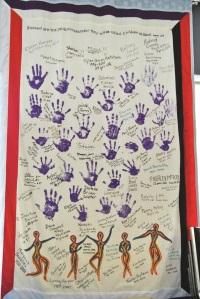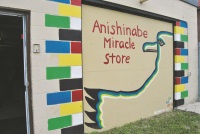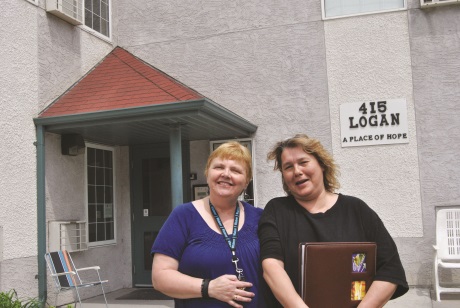It’s neutral ground, a place where gangs lay down their guns.
It’s where Michele has come to rebuild her life. The 51-year-old grandmother of eight shows just what the Winnipeg Inner City Missions, a Presbyterian Church in Canada ministry devoted largely to the Aboriginal community, is doing to help those who live in two of Canada’s poorest neighbourhoods, one on the edge of Winnipeg’s downtown, the other in the north ward.
Michele survived 10 years of working on the streets to feed a drug addiction and to keep a close eye on one of her daughters who worked the streets.
“I didn’t want the gangs to get to them. I would tell the guys never to give them crystal meth. It makes people crazy in the head,” she recalled of her life in north Winnipeg. “I let gang members in my house. I paid a big price. They always had guns.”
Fifteen years after that life began, Michele has come a long way. She is now in a unique position to help kids in the north ward. She runs the summer programs at Flora House, WICM’s oldest ministry, established in 1964. The outpost has a food bank, an after-school program for kids ages six to 10, and an evening program for older kids, ages 11 to 14.
“I see the girls I know out there. I still remember that life,” she said. Going to school and building healthy relationships weren’t on the agenda then. What mattered was survival.
Her journey from one side of the street to the other was long and intense. She has obtained her high school diploma, a child and youth worker certificate and is working on finishing her child and youth worker college diploma. Yet she can still recall the north-ward reality. It’s bleak. It’s tough to break the cycle of addiction and poverty. It’s even tougher to get out from under the control of gangs.
As Michele stood outside Flora House one day, she realized how far she’d come. “God showed me I was on the other side of the street. I was doing good things and giving back. If this is where I’m placed, so be it,” she said. “I remember what it was like walking up and down that street at 2 a.m., and now I am in bright sunlight and am accepted for who I am,” she said of her job with WICM. “I became part of something I never [imagined].”
Michele has been in and out and is back in Place of Hope’s three-year program, where she gets the support—physical, mental, emotional and spiritual—to carry on with her journey of healing and with her post-secondary studies.
 She had put her own healing on hold to help her oldest daughter, now 25, with her children, so she could go to school and beat her addiction. Her daughter is three years clean, following in the footsteps of her mother who has been clean for six years.
She had put her own healing on hold to help her oldest daughter, now 25, with her children, so she could go to school and beat her addiction. Her daughter is three years clean, following in the footsteps of her mother who has been clean for six years.
WICM’s Place of Hope opened in September 2007. Its 20 bachelor apartments offer adults ages 30 to 55 a place to begin again for those who are prepared to work their way out of poverty. Its First Steps program encourages and expects participants to take that first step to building a “normal life.”
“Some people have to get their ID [such as a health card and social insurance number]. Some are dealing with health issues. One girl had to have shoulder surgery and we advocated for her to get welfare, because she couldn’t work if she was living in pain,” said parish social worker Susan Currie. “Someone was fighting for workmen’s compensation for a year and a half. Anywhere else, he would have been kicked out. He’s still jumping through hoops and he couldn’t do it if he wasn’t here.”
Half of the residents have found work, while others are focusing on their high school diplomas or a college certificate or diploma.
The office for First Steps is in a three-storey building on Logan Avenue in the Centennial neighbourhood, where median family income is less than a third of the $66,343 Canadian family median income.
 From the office, program staff can see people coming in to the apartment lobby. “Our office is strategically placed, near the door in to the apartments. It’s like Mom asking you when you come home, ‘How was your day?’ Sometimes you see the look. Sometimes you see them hide from you,” said Currie, who does one-on-one counselling as well as advocacy for residents with government departments and other agencies that provide health and social services.
From the office, program staff can see people coming in to the apartment lobby. “Our office is strategically placed, near the door in to the apartments. It’s like Mom asking you when you come home, ‘How was your day?’ Sometimes you see the look. Sometimes you see them hide from you,” said Currie, who does one-on-one counselling as well as advocacy for residents with government departments and other agencies that provide health and social services.
The hiding is a sure sign some extra care is needed, a red flag that perhaps there’s been a slip back into an unhealthy habit or addiction. Quick, early intervention is critical. “We don’t let people hide in their rooms. If they’re working long hours, we’ll see them on the weekends,” she added, stressing that learning to live in a supportive community may be a new and challenging experience for those who come from families struggling with addictions and poverty.
At Place of Hope, the gospel is preached as well as practised, with a service on Sundays, along with Sunday school next door in the Anishinabe Fellowship Centre. Established in 1966, the centre is the older building on the downtown site, and includes a children’s centre where the Learn and Play group teaches not only the children but the caregivers. There’s space for community groups, 12-step programs and the Anishinabe Miracle Store. With clothes, bedding, toys and household items, the store can be the point of first contact, as anyone can come in to purchase items for 25 cents. There they meet up with nurse Jane Bishop.
The 25-cent price tag enables people to keep their dignity as they shop for the basics, and to chat with Bishop who can help link them to help they need.
Place of Hope meanwhile helps Michele manage her money and save towards first and last months’ rent, plus a damage deposit, a hand up when she’s ready to live on her own again. She looks at the certificates she’s earned, including first aid and various Aboriginal healing programs. She’s made peace with the past and she has goals, dreams and hopes for the future. She dreams of her driver’s licence and a car. She’s rebuilding her relationship with the infant son she let go years before, who is now a young man.
She gets inspiration and strength from her neighbours, a part of an extended family at WICM, where hope, opportunity, possibility and encouragement are its mission. “I know people coming into this building are working toward having a better outcome for their lives,” said Michele. “They’ve either burned themselves out or [are] used up. The ones who stay give me strength knowing it will get better and better.”

